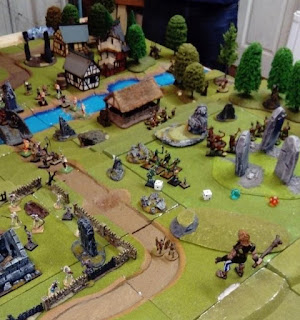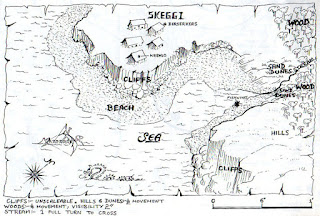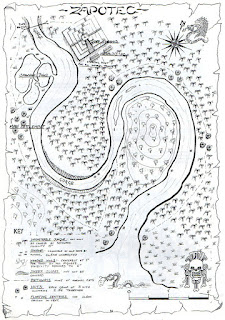In Search of the Dark Ages - Michael Wood
I think I remember seeing this criticised as being a "history of kings and queens" but I found Wood's style and subject matter to be immediately engaging. Given the period of time that Wood is seeking to cover the book is inevitably an overview, but still has a personal element that draws you into the narrative. A couple of episodes stood out to me as showing the nature of the early kings of the time, which built upon things I'd read previously but also brought them to life: firstly their need to travel constantly both to keep their personal connection to their subjects but also to consume their "taxes" (in the form of perishable goods or livestock) and secondly the uncertain nature of succession and the primary role of king as warchief. The latter is highlighted by an attempt to blind Æthelstan (and so disqualify him as king without murdering him), which has interests parallels from Sarantium to Tekumel.
Viking Age England - Julian Richards
In stark contrast to Wood, Richards' style (at least here) is as dry as can be. It contains a wealth of detail, ideal if say you're looking for resources for a game setting... But a slow read (even without my note taking) and giving very little feel for the personality of the time. One area where it does come to life is when dealing with religion and belief, as evidenced by burial practices. It seems that, if someone had been injured or mutilated in life (and hence not eligible for Valhalla), then animal parts might be substituted for the missing parts on burial, with ravens (sacred to Odin) and boars (a symbol of virility) being popular.
The Empty Throne - Bernard Cornwell
This sequel to The Pagan Lord caught my eye in my local library. Cornwell is a great writer, able to bring tension to scenes even when you know roughly how they're going to turn out - partly as he's now let slip that Uhtred will survive to be a grandfather, partly due to my growing knowledge of the period.
There's still plenty of interest though, and enough insights (or at least believable imagination thereof) into the feel of the period to make it a worthwhile, and page-turning read.
The Watchmaker of Filigree Street - Natasha Pulley
Another recommendation from my wife, the Watchmaker is very put-down-able at first so I'm not sure whether it'd still be languishing on the reading pile without that recommendation. Pulley's technical ability as a writer really shines through as you get
to grips with the novel, so it's a bit odd that the beginning's
interesting rather than compelling. It picks up though, and by the end I was totally gripped. It's somewhat hard to review though without straying into spoiler territory, which I try not to do.
The ending is tidy, but it's hard to see any of the characters being happy in the future. It's also not at all the story I was expecting, which is no bad thing, but on the other hand it's odd to have set up the Watchmaker's precognition and extraordinary mechanical skill and then tell a completely different story. I understand a sequel is in the works so perhaps these more steampunk elements will be explored further then, on the other hand the social side of his future - in many ways equally interesting given the setting - could well be the focus.
The Wolf Sea, The White Raven - Robert Low
Picking up from the conclusion of The Whale Road, The Wolf Sea takes us from Constantinople to Jerusalem in unpleasantly hot, sweaty detail. Low strikes a good balance between getting the Oathsworn to the end of the novel and having them being fearsome without having everything (or even most things) fall before them. They're convincingly out of their depth in Constantinople and out-maneuvered at various other points along the way, although it's becoming clear that their oath is also quite a handy device to keep them moving in the direction that the author wants - without it you can't see greed being enough motivation for what they go through. A great page-turner with some nicely surprising twists and, again, a fascinating view of the historical period. But a little too heavy on the grim to be truely enjoyable.
The White Raven is the cold and starving counterpoint to The Wolf Sea, and well up to the standard of the earlier novels in the series. One point I particularly liked was the presentation of slightly out of the ordinary exploits which you can quite plausibly see as growing into the basis of myths in the re-telling. Some good RPG fodder there. The other thing that's becoming clear is that, along with the oath device, the regular refreshing of the crew is another key tool for the author. The Oathsworn are more like a Star Trek crew than any other analogy I can think of - there's a tight focus on a few key members, and a lot of the secondary characters are actually redshirts (although this fact is often well concealed until the fatal moment). Looking at the books through an RPG lens, as with Cornwell's Saxon tales a great selling point of the period is that a boat load of armed men can quite often (but not always) set their own destiny. I can't immediately see how that could translate to a typical RPG group, but perhaps I'm starting to get there.
The Prow Beast - Robert Low
I'm finding the Oathsworn books annoyingly unputdownable - I'm feeling I've read enough Vikings for now and should be reading more broadly, and have plenty of other things to be doing besides! But having seen this on the shelf in my local library I've read it as fast as real life would allow.
Low seems to want to show us as much of late 10th century Europe and the Near East as he can, which suits me down to the ground and, despite us knowing Orm is due a ripe old age, he fills the tale with tension as well as interesting but not overblown detail. They're not cheerful tales though - Low treats his protagonists about as well as Robin Hobb does (my benchmark for protagonist misery), but the Oathsworn treat those around them equally harshly so that's probably fair. It does leave me though wanting some sort of palette cleanser or two before I seek out Crowbone (currently the last in the series).
Déjà Dead - Kathy Reich
Having had enough of Vikings for a while a diversion into murders and post-mortems seemed a good idea at the time! A decent book, this doesn't really live up to its blurb. Reichs clearly knows her stuff as a forensic anthropologist but if you don't know your iliac crest from your glenoid fossa then a lot of the procedural description is just words on a page, which is a shame as this seems to be the book's main selling point. Without them it's a good enough thriller, but not really one to seek out.
A Wizard of Earthsea, The Tombs of Atuan - Ursula le Guin
The fact that this is a classic helped me stick with it when otherwise I might not have. Le Guin's writing style is rather remote, and her main character slightly irritating at first. About a third of the way through A Wizard of Earthsea things pick up somewhat, although I would rate this book as interesting rather than great - and annoyingly it leaves some rather large questions about the world, where magic seems relatively common, unanswered.
The writing style is better suited to The Tombs of Atuan, where it matches the narrator's cold upbringing. A good tale, well told, but not really matching my expectations when I picked up the book.
The Girl on the Train - Paula Hawkins
It's good to see this was billed as a psychological thriller - I worked out who done it 72% of the way through, so it's clearly not a whodunnit (which I never get right!). In some ways like Gone Girl in that it uses the power of the narrator's point of view to paint you one picture, and then a very different one, this book is an uncomfortable read in places but a thoroughly worthwhile one. It's slightly let down by the ending not being entirely convincing but that's a fairly minor blemish in an otherwise very good novel.
Hild - Nicola Griffith
It's clear that Griffith did an enormous amount of research for Hild, but she does a fantastic job of showing, not telling, in order to deliver a thoroughly interesting viewpoint of the early middle ages and also a great story. Hild's is an interesting perspective - constrained by her gender to have only a second-hand account of most of the battles in the book she in some ways becomes an "everyman", waiting on the uncertain outcome of events over the horizon along with the sort of folk who don't get much attention in your typical novel of the period (or most periods come to that). However she's also an extraordinary character, close enough to her king see a lot more of the world, and the events that shape it, than most.
It's a weighty book, and my passage through it was made slower by all the notes I was making, but I'm keenly looking forward to the rumoured sequels.
The Pilgrim of Hate - Ellis Peters
Pilgrim of Hate is an interesting antedote to Hild, in that it demonstrates that you can write perfectly passable historical fiction with only the thinnest veneer of history included. Definitely a whodunnit this one, so I didn't have a clue what was going on until Cadfael explained it. As with Rivers of London there's a central deception of the type I'll fall for every time (and which I really must steal for use in an RPG plot one day). A good holiday read (no notebook needed!).
The Lazarus War: Artefact - Jamie Sawyer
I picked this up as a page-turning read, more military sci-fi than high concept, so I'm being unfair to be slightly disappointed with it. It's both well written (keeping you going for one more chapter, when it's far later than you realised) while also somehow clumsy - it sometimes feels as though it's been assembled from a sci-fi kit of parts. And it touches on issues that it perhaps should be exploring: what would be the psychological impact of the contempt that Harris-as-simulant feels for the puny humans around him; how debilitating to be in the position of having his own life on the line rather than that of the disposable simulant? Sawyer opens these questions and then veers back to the main, rather pedestrian but anyhow gripping plot.
As a novel it ticked the boxes I was looking for when I picked it up, so I really should give it due credit. It's the first in a series so perhaps these questions will be addressed - but rather unfairly I'm not feeling motivated enough to seek out the others in the series.
Tigana - Guy Gavriel Kay
It's apparent enough from the story itself but the author's afterword makes it clear that this is a novel with a message, unfortunately for me this made it weaker than those of Kay's books which I've read previously. A perfectly good book, if long, and with perhaps a slightly contrived ending, spiced up by some nice twists throughout. For all my reservations, the ending still kept me gripped, in a "stay up far later than I ought" way. But still not up to the standard of say his Sarantium novels.
Fortune's Pawn - Rachel Bach
After the last few books I was looking for a slightly lighter read that I could dip into and out of, and this was exactly what I needed. Fortune's Pawn is odd in that the narration isn't quite convincing, it feels rather forced especially at the beginning as if Bach doesn't really understand her heroine. Once it gets going though the plot becomes interesting, and then intriguing - I'll definitely be seeking out the next in the series.
Flamesong - M.A.R Barker
Another interesting trip to Tekumel. As with The Man of Gold it gives a good insight into the world and how a roleplaying game might fit there, although the trial of Trinesh and his companions towards the end of the book also highlights its limitations as a game setting. Barker also does a good job of presenting lost technology, which can be a tricky challenge when the reader is more tech-savvy than the protagonist. Conversely the book definitely lacks for a map, even a very rough one - the characters' discussion of their travels, perhaps understandable to someone more familiar with the geography of Tekumel, left me completely in the dark.
For me this remains a fascinating but intimidating setting. As far as I can tell from reviews the books go rather downhill from here, so I'm not sure how much further I'll explore it.
On Basilisk Station - David Weber
No subtly here, Honor Harrington's world is not painted in shades of grey. Weber's writing is impressive, he was able to lead me around via the nose emotionally - you're rooting for Honor, and booing her enemies. Perhaps unsurprisingly given its black and white nature, it's hopefully not too much of a spoiler to reveal that the tale turns out OK in the end, although there are setbacks and loses along the way. For me though it turns out a bit too well, and while I thoroughly enjoyed the book I was left with no interest in its sequels. It has the feel of a TV show where no second series is planned, so when a sequel is decided on the first order of the day is to tear the hero back down so they can be built up. I think I can manage without.
The Wilful Princess and the Piebald Prince - Robin Hobb
It's Robin Hobb so I wasn't expecting a happy tale, but this is unexpectedly downbeat. The narrator and the other main characters are all rather unsympathetic, and the more sympathetic a character is the more remote they are in the telling. And it being Hobb there's an air of doom over the whole thing. This all adds up to make a good (but short) story rather put down-able which is a shame. For several reasons I found it well worth my time: as a chapter in the history of Buckkeep; as a demonstration of a storytelling style and for the story itself. As often with Hobb's stories I find myself wanting more - but after a bit of a break.
The Lies of Locke Lamora - Scott Lynch
This book came highly rated from various people on G+, but I found it hard to enjoy at first. Locke is an interesting but rather smug character and it wasn't until the stakes ramp up considerably with his introduction to the Grey King that it starts to become more enjoyable. From there it slowly builds, via various ups and downs, to a brilliantly executed climactic scene.
The setting of the city of Camorr is almost a character in its own right, Renaissance with a slight sprinking of clockpunk (or at least modernity), along with the "aliens did it and ran away" mystery of the Elderglass. You're left torn between hoping Lynch will explore these in more detail in future versus hoping they're left well alone as an interesting but unexplained backdrop.





































